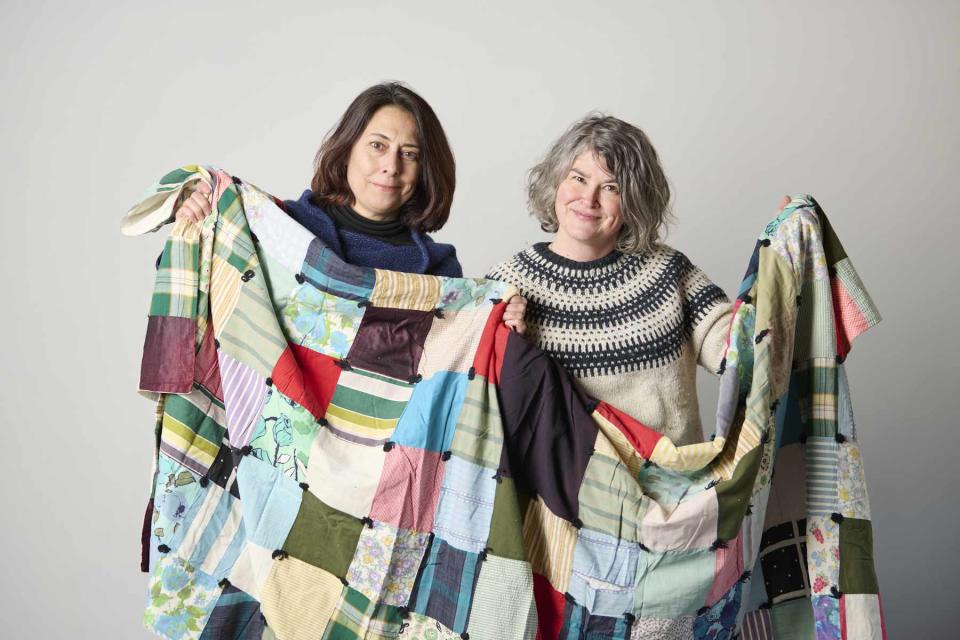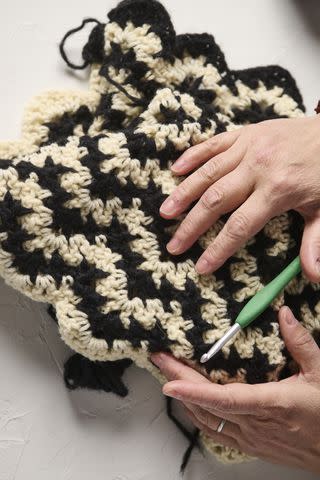For Families Missing Loved Ones After Loss, This Company Is Making Miracles
Loose Ends turns the unfinished projects of people who have passed on into tokens of love, an especially noble cause during the holidays.

Loose Ends Project, Winky Lewis
“Thirty thousand!” Jen Simonic exclaims, tallying up the number of stitches it takes to knit a pair of socks. “That’s thirty thousand movements and intentions, and not purling when you’re supposed to knit, and making sure it fits the foot you’re making it for.”
Simonic is an expert on knitting and well-versed in the many types of fiber arts having first picked up a pair of knitting needles at the age of six, when her grandmother who used to knit bandages for loved ones in World War II, began to teach her the craft using tiny steel needles. Because of her many years of experience, Simonic is comfortable working on projects with impressive numbers, which comes in handy as Loose Ends, the organization she co-founded with her friend and fellow knitter, Masey Kaplan, has grown exponentially since its inception last year.
Simonic credits Kaplan with the creation of the organization which connects volunteers with projects left behind and unfinished when other creators pass away. “The whole thing was Masey’s brainchild. It sprung out of her head, she came up with the title and everything,” she says.
“It’s been a very fast rise,” Simonic notes, referencing the worldwide attention the organization has garnered in the past few months. “If you talked to me in October of last year, we only had 300 finishers in Maine and Seattle,” Simonic shares, referencing the individuals that make up the volunteer community of crafters. That number has now grown to more than 18,000, with members in 63 countries around the globe.
Building Community After Isolation
Simonic says that the idea behind Loose Ends isn’t new—pointing out that in years past, when many people’s communities centered around their religious beliefs people would come together in churches or for major life events like weddings and births and make things for each other.
“Think quilting bees,” Simonic says. “Old time-y barn raisings. People came together and there are still guilds in America and around the world today that do this and finish projects for each other.”
For her, the difference in Loose Ends isn’t in what they do, but what has been bringing people together: a longing for community and connection.
“In this day and age and especially within the last three years, we’re really isolated,” Simonic adds, noting that the organization has struck a chord with the people who find them. “It’s a balm that there are people out there that want to do nice things.”
“We’ve all gone through so much loss recently,” she said, referencing the years of pandemic isolation, pointing out that this has brought together people from a diversity of backgrounds—crossing barriers of geography, political affiliation, religious belief, and even generational divides.
“The people who are finishers are not a monolith. They’re this really weird and interesting group of people who just stepped up and said ‘I have this craft that I can do really well, and I want to help. How can I help somebody who’s in need?’”
Making Invisible Labor Visible
As Simonic and Kaplan work to bring together fellow fiber artists and creators from around the globe, Simonic says their mission goes far beyond simply finishing scarves and blankets.
“We’re helping to make visible the work that other people have left behind,” she says, acknowledging that in large part, this means making visible the invisible labor of women, who in many families are the makers and creators.
“I use mom a lot or sister because honestly a lot of our projects are from women,” Simonic says. “Not that we don’t have projects from men—we do have some—but 80 percent are from women,” Simonic says that regardless of who left the unfinished pieces behind, these completed projects can be incredibly meaningful for the family members who receive them.
Recently, a special challenge came their way from Anne in New Zealand—the first request from her country. A century-old lace-edged handkerchief had been left unfinished by her grandmother, who was born in England in 1880 and went on to become an award-winning needlewoman. Loose Ends connected Anne with a finisher named Daisy, who completed the handkerchief. In a grateful note shared with the Loose Ends team, Anne noted, “I have received the handkerchief, and your needlework is exquisite. It was only when I spotted the tiny rust marks left by my Gran's needle was I able to notice where her handiwork ended and yours began. She would have commended you.”
Simonic, who went to school for microbiology, says humans shed cells every time they touch something, and so projects that individuals complete have a value far beyond their monetary worth.
“There’s DNA in everything you make,” she says. “It’s this thing that gets passed down that someone has been touching. It’s a tangible token of the love a person was feeling for them, and it’s a shame when these things go unfinished.”

Loose Ends Project/Winky Lewis
Looking Toward the Future
While Loose Ends started as a local group built on Facebook message boards and local crafting groups, Simonic says they now have finishers across the globe in countries as far away as Iran, Ukraine, Hong Kong, and China.
“We have people everywhere,” she notes, “and when people don’t have a project we tell them to take a flier [from our resource page] and we’ll find them one. I just recently matched someone with a quilting project two miles from her house.”
Simonic notes that they always try to connect finishers with projects that are local to them, explaining that shipping expenses and their commitment to keeping the carbon footprint of the projects as low as possible are important to them. But ultimately their goal is to bring people together.
“Mostly we want them to connect, and to know there’s somebody out there who cares.”
She remembers one project that was particularly poignant to see completed—a piece of fiber art that had been left behind when the artist died by suicide. The woman’s mother sent the project to Loose Ends and a finisher was able to complete the custom work of art, even including the original creator’s initials in one of the project gaps.
“One of our finishers got this project and turned it into a rainbow, and filled in all the holes with just one color, with granny squares,” Simonic says. “She got really immersed in it and figured out how to do it, and it ended up being a queen-size quilt.”
The mother loved the finished project so much that she asked if she should turn it into a wall tapestry to display, but Simonic had another idea.
“I think you might want to wrap yourself in it once in a while,” she told the mother.
While many of the projects finishers work on are truly functional—unfinished scarves, hats, mittens, and afghans are often found by family members after a loved one passes—some items added to a finisher’s queue are more ornamental. To Simonic, there’s beauty and purpose in finishing those projects too.
“Part of the appeal here is that some of these things are decorative, and what is life without art?” she asks, remembering one project in particular––a set of needlepoint art left unfinished when one man’s wife passed away.
“It was something they had picked out together that was going to decorate their walls,” Simonic says. “To him, it was a daily reminder of their life together. What’s more beautiful or practical than that?”
When it comes to future plans for the organization, Simonic says she’s excited about the possibilities to grow and expand their mission, connecting even more volunteers with projects––a goal that is much more feasible now thanks to a new formal sponsorship with JOANN Fabric and Crafts, which had been donating necessary resources to finishers from the inception of Loose Ends. The nationwide crafting chain popular with hobbyists across the country will now help fund the mission of Loose Ends, as well as continue to connect finishers with materials whenever needed.
A Life Worth Living
For Simonic, co-founding Loose Ends was always about more than just tidying away a loved one’s yarn stash and finishing a few sweaters that had been left behind.
“What makes us alive?” she asks. “As a science teacher I know there are things we do that make us alive, but it’s the things that fall outside of that that make us human.”
“What makes our lives worth living is knowing people loved and cared for and appreciated us, and what better use of someone’s time than to make something that demonstrates that love? That’s what we do.”
For more Parents news, make sure to sign up for our newsletter!
Read the original article on Parents.

